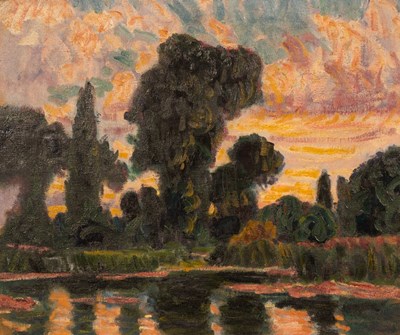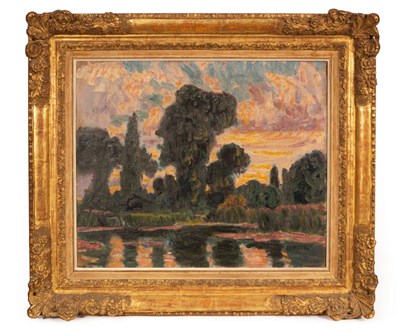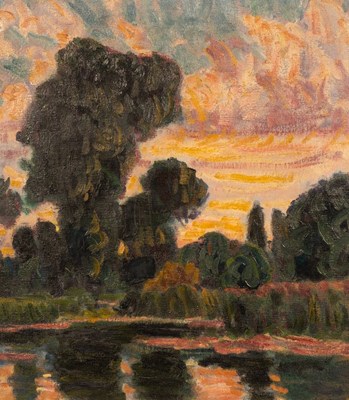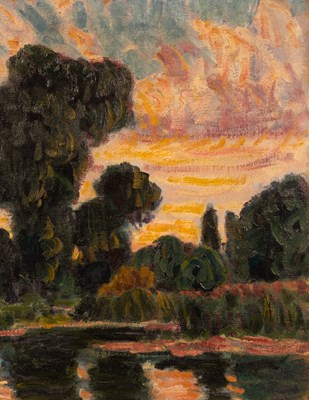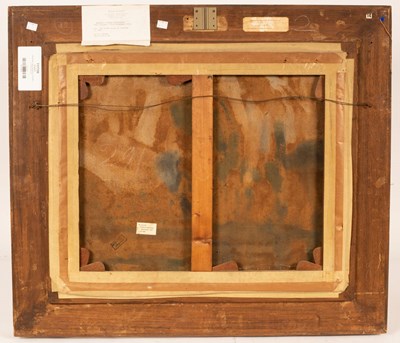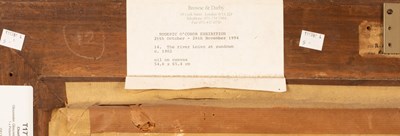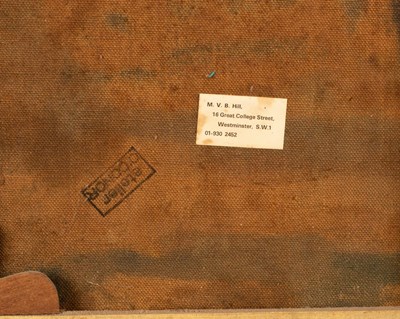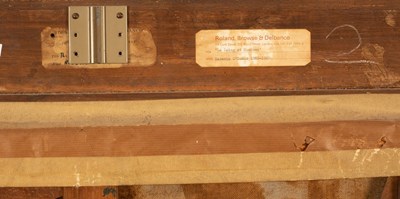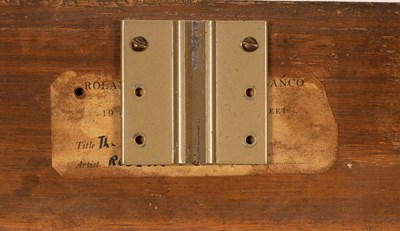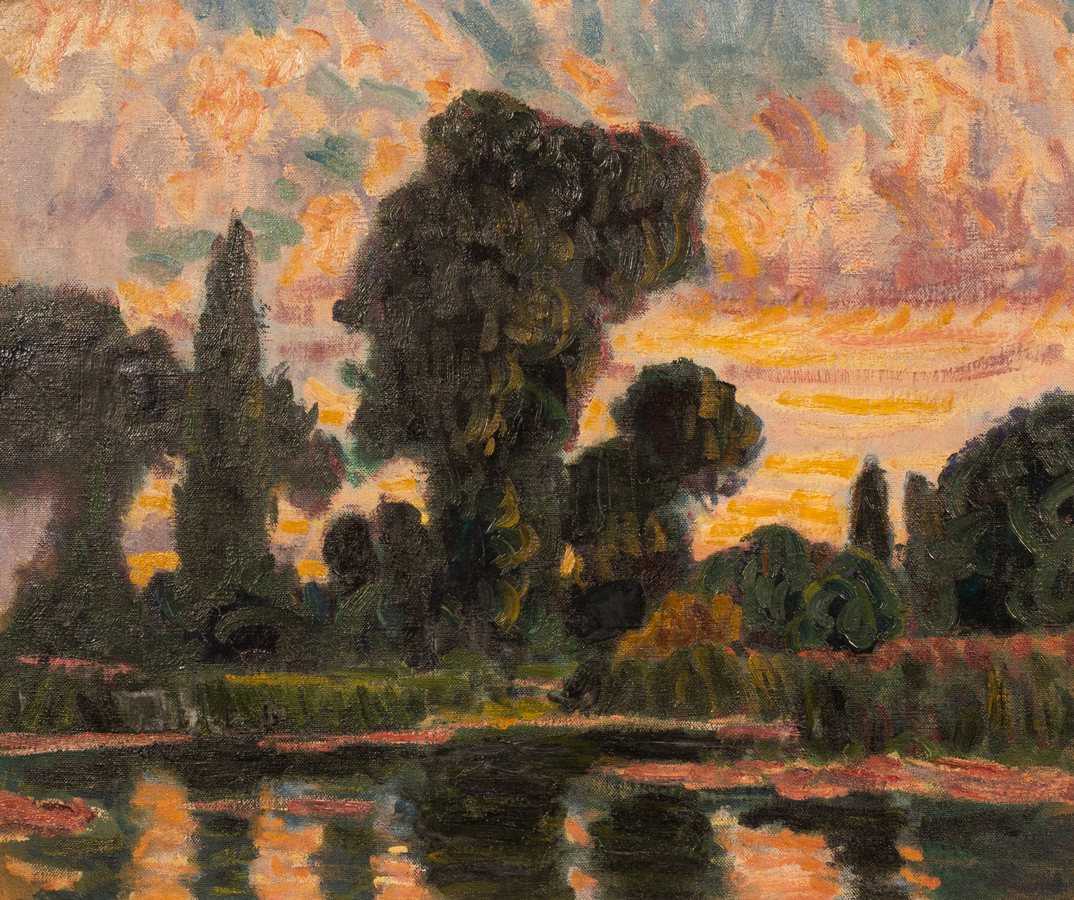5th Dec, 2022 14:00
19th & 20th Century Paintings
2
Roderic O'Conor (1860-1940)/Le Loing at Sundown, circa 1902/stamped verso: 'atelier/O'CONOR', oil on canvas, 54.6cm x 65.4cm/Provenance: Studio of the artist, sold Hôtel Drouot, Paris, 7 February 1956; Roland, Browse & Delbanco, London; Lt. Col. M.V.B Hill; by descent/Literature: Jonathan Benington, Roderic O'Conor, a biography with a catalogue of his work, Dublin 1992, p. 202, cat. 101, and reproduced in colour, pl. 34/Exhibited: London, Roland, Browse & Delbanco, Roderic O'Conor paintings; collectors' drawings, 19th and 20th Century , 1957, no. 12; London, Roland, Browse & Delbanco, Roderic O'Conor, a selection of his best work, 1971, no. 9; Browse & Darby, London, Roderic O'Conor 1860 - 1940, 1994, no. 14/Note: Montigny-sur-Loing is a small town on the edge of the forest of Fontainebleau, 75 kilometres to the south-east of Paris. In the late nineteenth Century it could easily be reached by train from the capital and was the point of disembarkation for scores of artists, drawn as they were by the attractions of forest, river, sunshine and youthful camaraderie. O'Conor first discovered the town in the late 1880s when he was a student in the atelier of Charles Carolus-Duran in Paris and spent several summers at nearby Grez-sur-Loing, where fellow Irish painters John Lavery and Frank O'Meara had recently been in residence. O'Conor's fondness for the Loing was such that he returned to the area several times in the mid-1890s, staying either with his friend the American painter Francis Chadwick, or with the English etcher Arthur Heseltine. In August and September of 1902 O'Conor returned again, this time in the company of another American friend, Guy Ferris Maynard. On this occasion, however, his motivation went beyond the renewal of old acquaintances, for he had brought painting materials with him, no doubt welcoming the change in terrain from his usual base in Pont-Aven, Brittany. Short though it was, the move triggered a renewal of his interest in painting landscapes, such that by the time of his return to Brittany in early October he had created a series of tranquil views of the River Loing bordered by trees that were just beginning to show their autumn colours. Many of these paintings, of which Le Loing at Sundown is a typical and fully resolved example, were concerned with the half-light and the mystery of partially revealed forms. They also evinced a breadth of handling that demonstrated O'Conor's proto-Fauve credentials, just as his daring Breton seascapes had done three years earlier. Whilst in swapping the fast-flowing River Aven for the much slower and broader Loing O'Conor may have removed himself from the rugged terrain to which he was accustomed, he remained true to his modernist allegiances. This is especially apparent in the thick and gestural brushstrokes with which he has painted the trees and sky In Le Loing at Sundown, conveying the effects of a breeze. Indeed the large tree at the centre of the Montigny composition has the whipped outlines of the trees in some of his Breton etchings of 1893. To render the failing light he has deployed a palette of bright colours, including pink, purple and two different yellows, exaggerating the local colours of the scene itself. The derivation of this technique, still highly radical in 1902, reverts back to the artist's precocious discovery of Vincent van Gogh (the expressionist gestures) and Paul Gauguin (the exotic palette) a decade earlier. It is perhaps no accident that one of the seminal lessons in modernist painting was given in 1888 on the banks of the River Aven when Gauguin instructed the young Paul Sérusier: ''What do those trees look like? You see them as yellow: very well, put on some yellow; and as for that shadow, which looks blue if anything, paint it pure ultramarine! Those red leaves? Take some vermilion!'' As O'Conor would have known, the picture painted on that occasion, The Talisman, was famously carried back to Paris and shown to Sérusier's fellow-students at the Académie Julian. It is now one of the treasures of the Musée d'Orsay. Jonathan Benington, August 2022
Sold for £120,000
Roderic O'Conor (1860-1940)/Le Loing at Sundown, circa 1902/stamped verso: 'atelier/O'CONOR', oil on canvas, 54.6cm x 65.4cm/Provenance: Studio of the artist, sold Hôtel Drouot, Paris, 7 February 1956; Roland, Browse & Delbanco, London; Lt. Col. M.V.B Hill; by descent/Literature: Jonathan Benington, Roderic O'Conor, a biography with a catalogue of his work, Dublin 1992, p. 202, cat. 101, and reproduced in colour, pl. 34/Exhibited: London, Roland, Browse & Delbanco, Roderic O'Conor paintings; collectors' drawings, 19th and 20th Century , 1957, no. 12; London, Roland, Browse & Delbanco, Roderic O'Conor, a selection of his best work, 1971, no. 9; Browse & Darby, London, Roderic O'Conor 1860 - 1940, 1994, no. 14/Note: Montigny-sur-Loing is a small town on the edge of the forest of Fontainebleau, 75 kilometres to the south-east of Paris. In the late nineteenth Century it could easily be reached by train from the capital and was the point of disembarkation for scores of artists, drawn as they were by the attractions of forest, river, sunshine and youthful camaraderie. O'Conor first discovered the town in the late 1880s when he was a student in the atelier of Charles Carolus-Duran in Paris and spent several summers at nearby Grez-sur-Loing, where fellow Irish painters John Lavery and Frank O'Meara had recently been in residence. O'Conor's fondness for the Loing was such that he returned to the area several times in the mid-1890s, staying either with his friend the American painter Francis Chadwick, or with the English etcher Arthur Heseltine. In August and September of 1902 O'Conor returned again, this time in the company of another American friend, Guy Ferris Maynard. On this occasion, however, his motivation went beyond the renewal of old acquaintances, for he had brought painting materials with him, no doubt welcoming the change in terrain from his usual base in Pont-Aven, Brittany. Short though it was, the move triggered a renewal of his interest in painting landscapes, such that by the time of his return to Brittany in early October he had created a series of tranquil views of the River Loing bordered by trees that were just beginning to show their autumn colours. Many of these paintings, of which Le Loing at Sundown is a typical and fully resolved example, were concerned with the half-light and the mystery of partially revealed forms. They also evinced a breadth of handling that demonstrated O'Conor's proto-Fauve credentials, just as his daring Breton seascapes had done three years earlier. Whilst in swapping the fast-flowing River Aven for the much slower and broader Loing O'Conor may have removed himself from the rugged terrain to which he was accustomed, he remained true to his modernist allegiances. This is especially apparent in the thick and gestural brushstrokes with which he has painted the trees and sky In Le Loing at Sundown, conveying the effects of a breeze. Indeed the large tree at the centre of the Montigny composition has the whipped outlines of the trees in some of his Breton etchings of 1893. To render the failing light he has deployed a palette of bright colours, including pink, purple and two different yellows, exaggerating the local colours of the scene itself. The derivation of this technique, still highly radical in 1902, reverts back to the artist's precocious discovery of Vincent van Gogh (the expressionist gestures) and Paul Gauguin (the exotic palette) a decade earlier. It is perhaps no accident that one of the seminal lessons in modernist painting was given in 1888 on the banks of the River Aven when Gauguin instructed the young Paul Sérusier: ''What do those trees look like? You see them as yellow: very well, put on some yellow; and as for that shadow, which looks blue if anything, paint it pure ultramarine! Those red leaves? Take some vermilion!'' As O'Conor would have known, the picture painted on that occasion, The Talisman, was famously carried back to Paris and shown to Sérusier's fellow-students at the Académie Julian. It is now one of the treasures of the Musée d'Orsay. Jonathan Benington, August 2022
Auction: 19th & 20th Century Paintings, 5th Dec, 2022
